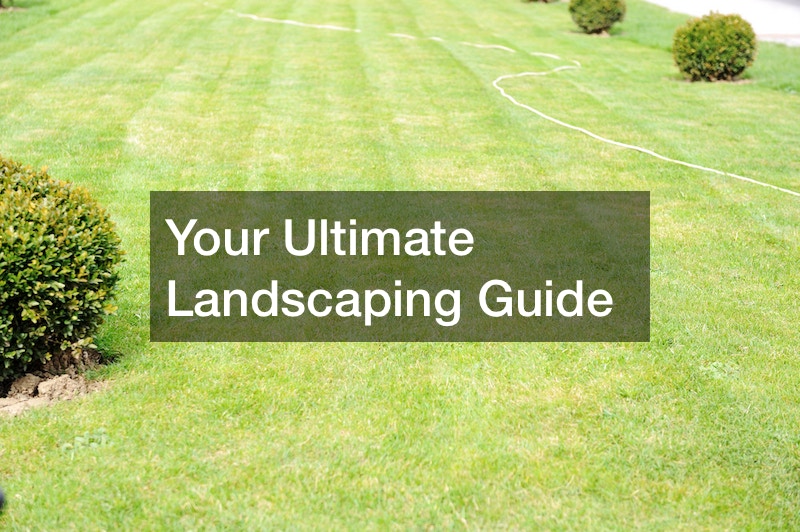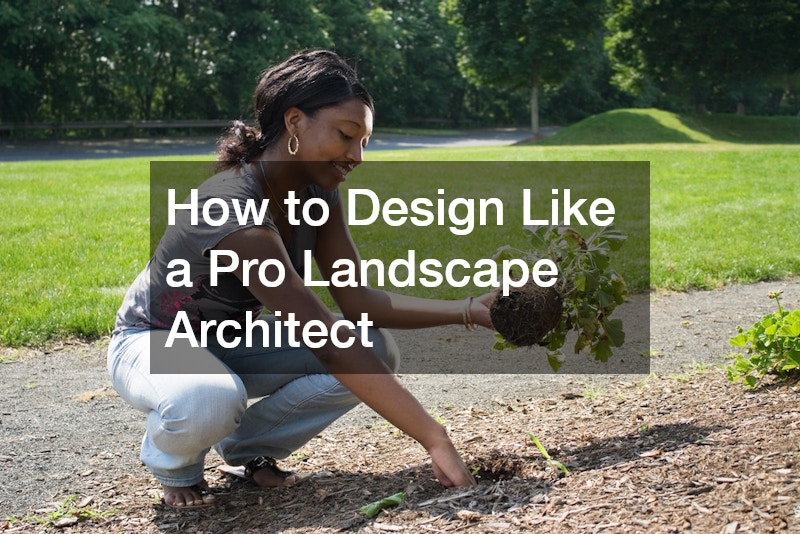Do you aspire to own a lovely backyard where you can relax, host events outside, or just enjoy a quiet morning cup of coffee amidst luscious greenery? Are you debating whether hiring a professional landscaper or doing it yourself is more cost-effective?
Any gardener or landscaper will tell you that landscaping can be laborious, but consistency is essential. There are many methods to improve the appeal and functionality of your yard, from plants and design to plants and outdoor lights. This landscaping guide will give you a comprehensive overview, outlining its essential steps and providing guidance for a job well done.

Hire Professional
Finding someone who can translate your personality into an outside space that you will love can be difficult because your garden reflects your home’s and own personalities. A competent professional landscaper will consider your needs while ensuring the landscape is functional. You can choose the best plants for your area with the assistance of a lawn expert.
According to the Tree Care Industry Association, improper tree work is to blame for about 45% of accidents involving trees. Since local tree cutting companies are experts in tree maintenance, branch trimming, and safe tree removal, they play a significant role in our landscaping guide. Your outdoor area will continue to be safe and beautiful, thanks to their expertise.
An expert will consider the hues that best complement your home’s exterior. Additionally, they can take a concept you had for your yard or one you read about in a magazine and bring it to life. A landscaping business can assist you in saving money. Due to their experience, pros can avoid blunders you would face if you attempted to complete the task alone.
A professional landscaper also knows the qualities required for your yard and plants to thrive. This expertise helps you purchase the appropriate items, saving money. A skilled landscaping company will appoint a crew of more than one individual. With a great landscaping guide and expert on your side, you can speed up the process and complete your landscaping swiftly.
Plan and Design
According to the Arbor Day Foundation, planting trees can raise your home value by 15% – and people like being close to trees. However, landscaping is more than just beautifying a yard. When it rains in the spring and fall, your yard can turn into a mud puddle without a proper landscaping guide.
Flooding can harm the plants and current landscaping, making the area unusable. The proper design redirects rainfall and runoff away from plants. Both hardscape and landscaping components are part of a successful landscape design. Non-living objects like rocks, walls, patios, arbors, or water features are examples of hardscape elements.
Consider hiring a qualified arborist to help you create and develop a plan and landscaping guide. Landscape design aims to make your yard a lovely retreat while reducing the negative effects of human activity on the local vegetation and ecosystem. Collaborating with arborists is a key step in this process.

Pick the Right Plants
Picking the ‘right plant for the right place’ is crucial for all landscaping styles. Ignoring this could result in more maintenance, a failure of the plants to thrive, and occasionally, even the death of the placed plant material. Applying the concept begins with careful preparation and a site assessment.
In addition to their decorative appeal, choosing plants that meet the site’s growing conditions is crucial. Even the best planting techniques won’t help a plant thrive if the location isn’t right. For instance, landscaping with native plants can drastically reduce water usage. According to the Environmental Protection Agency, more than half of the outdoor water is used to water plants and lawns. You can reduce water needs and contribute to water resource conservation by using native plants in landscaping.
Consider where you want to put your plants, trees, and flowers. Give them enough room to develop strong roots underneath and to expand as wide and tall as they need to above ground. You can get help from qualified local arborists to ensure you space every landscaping perfectly!
Soil
The cornerstone of every landscape design is the soil, and the health and aesthetic appeal of your plants and flowers can greatly vary depending on the type of soil you choose. Choosing the best soil for your needs can be overwhelming, though, because of the many different types available.
The three basic types of soil are silt, clay, and sand. The greatest particle size, sand, offers adequate drainage but poor water retention. Silt is medium particle size and offers a decent water retention and drainage combination. The smallest particle size, clay, is good at holding onto water but can also become compact and impede root development.
As we stress in our landscaping guide, fertilizing is crucial for preserving the soil’s fertility and structure and ensuring plants have access to the vital nutrients they require to thrive. According to Crop Nutrition, well-fertilized soil can yield up to a 40% increase in plant growth. Developing a deeply ingrained vitality in your landscape is more important than just emphasizing its outward beauty. Additionally, it’s crucial to consider the plant’s needs while selecting soil for a particular plant or flower. For instance, although moisture-loving plants like ferns demand soil with high water retention, succulents, and cacti require well-draining soil.

Variety
A varied terrain increases visual appeal and practical variety. Although it may be tempting to take a ‘simple’ approach and install a grass carpet with a few favorite shrubs, this may not yield the best results. You won’t get a very appealing result that way, and you might be passing up a chance to increase the worth of your house. This landscaping guide recommends a more diversified landscaping plan for a number of reasons.
The first benefit is insurance against disease. Suppose you have spread a plant that you adore around your yard. You can end up in a desolate environment if those plants succumb to a fungus or other pest. The majority of your landscape should survive such an issue because of variety. When selecting trees, this is especially crucial to take into account.
Another advantage is maintaining a beautiful yard all year. Every season of the year, various plants will produce different foliage and blooms. Your yard will only look good for a portion of the year if you plant one or two things, and it will be unattractive during other seasons. Keep in mind that a varied landscape doesn’t necessarily require extensive maintenance. If you’re worried about upkeep, landscaping companies can recommend low-maintenance options.
Outdoor Lighting
Picture a time when you were completely mesmerized by a landscape. You were probably drawn in by more than simply the attractive trees, plants, or other architectural features. It was also lit artistically. The right outdoor lighting can significantly enhance the look and feel of your landscape, just as an attractive lighting design inside your home can make a room feel more inviting.
Consider the architecture of your landscape, your lighting objectives, and your preferences when selecting the lighting for your outdoors. For instance, modern lighting can work well in a sleek and contemporary garden. It’s also crucial to think about the purpose of the lighting: do you want to illuminate a pavement, draw attention to a particular feature, or foster a cozy ambiance for outdoor gatherings?
Your top focus should also be your safety. Always keep in mind that water and electricity can be hazardous when combined. You might need to engage a tree removal service and a licensed electrician for hard-wired lighting.
Also, take into account the view from inside your house. A light shining right into your window is the last thing you want. Finally, when it comes to landscape lighting, less is often more. Rather than many, a few strategically positioned lights can produce a pleasing appearance.

Protect It
If you do not take some preventive measures, your yard and garden will suffer a few setbacks in the quest for a lovely home setting. With ripped grass, broken branches, trodden flower beds, a damaged root system, and compacted soil, your newly planted geraniums will suffer if you disregard their well-being. Our landscaping guide looks at several strategies to ‘Protect It’ and keep your landscape looking good for a long time.
Regular maintenance is a crucial component of protection. This entails routine trimming, weeding, and rapid problem-solving. For example, pruning keeps trees and shrubs healthy and in shape, preventing overgrowth and potential safety problems. By performing routine care, you keep your landscape from deteriorating and ensure it thrives.
Fences are a fantastic method to secure your outdoor living area and guarantee the safety of your family and pets as they enjoy the great outdoors. Statistics highlight the importance of a fence even more. According to the Home Remodeling Costs Guide, a well-built fence can raise a home’s value by up to 50%. In addition to keeping your family and pets safe while enjoying the outdoors, fences are a terrific method to safeguard your outdoor living space. Consider hiring a fence contractor for outdoor landscaping projects to help you define the boundaries, provide a sense of security and privacy, or both.
Pruning
Both young and mature plants can benefit from pruning as a preventative care technique. A regular trimming routine protects your plants, family, and property from harm, pests, and damage. It’s a crucial element of a long-term maintenance plan.
Pruning removes dead branches and stubs to promote new growth and prevent damage to property and people. It prevents pest and animal infestations through soil remediation and encourages the plant’s natural shape and healthy growth.
Regular pruning lowers the possibility of storm-related branch damage to buildings. Avoid having branches fall over driveways, walkways, and children’s play areas to protect your family and friends. Because there are fewer places for pests, vermin, and snakes to live, this approach also aids in pest management. It also improves the aesthetics of the hedge and maintains the density and proportion of the evergreens. In this landscaping guide, we’ll emphasize this type of maintenance to improve your property’s planned layout and look.
Hardscaping
What is hardscaping, though? Everyone is familiar with landscaping. The phrase describes components of artificial or non-living outdoor design enhancements. You might picture trees or bushes when you think of landscaping. Consider features like walkways, fire pits, patios, and retaining walls when planning your hardscaping.
Hardscaping and landscaping frequently go hand in hand when a person envisions their ideal yard. But what substances are employed in hardscaping tasks? The answer will vary depending on the type of project you’re working on. For instance, brick is a typical material that blends well with most gardens. It helps build a wall, and because of its adaptability, you may even use it to make a wonderful flowerbed.
You can create beautiful patios, walks, or paths with pavers and stones. Because flagstone or cobblestone have a natural appearance, they won’t compete with other features of your landscape but will enhance them. Paved surfaces can still be lovely and make for a comfortable stroll through your garden, even though they might not accomplish this natural aesthetic as well as unpaved ones.
In a nutshell, there are many possibilities available to you when it comes to transforming your backyard into a sprawling paradise. The 2021 True Cost Report from Home Advisor estimates that hardscapes typically have an ROI of roughly 40%. So if you think, ”It’s time to sell my house,” hardscaping will increase your home’s value.
Sustainability
Modern landscaping is more concerned with sustainability. We can protect our regional ecosystems by adopting sustainable landscaping techniques and stopping soil, water, and air pollution. It should have a pleasing atmosphere that blends in with the climate where it is located and uses the least amount of water, fuel, fertilizer, pesticides, and other resources. Landscape practices like xeriscaping, grasscycling, erosion control, water conservation, carbon sequestration, habitat creation, mulching, and composting can enable more environmentally friendly and climate-appropriate landscapes.
Another essential component of sustainability initiatives is incorporating environmentally friendly elements, including solar-powered electric gates. As a result, you use less energy and leave a smaller carbon imprint. Sustainable features like electric gates are crucial to promote an environmentally responsible approach to landscaping and simultaneously improve security and sustainability.
Sustainable landscaping is also simpler than you might imagine. Responsible landscaping is not just environmentally benign; it is also, by nature, low-maintenance. They may also be significantly more affordable! However, creating a sustainable environment does take extensive planning and research.
Landscaping is all about designing an outdoor space that is both aesthetically pleasing and functional. As we discussed in this landscaping guide, there are many ways to make your outdoor space awesome. To prevent your project from becoming overwhelming, take it one step at a time. Several small, ongoing changes over time can transform your yard into your desired paradise.


